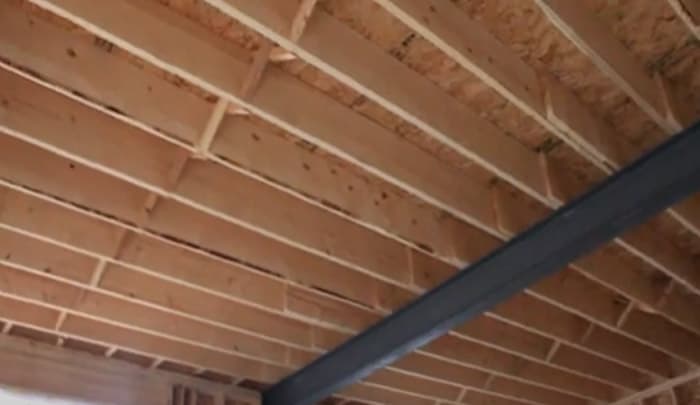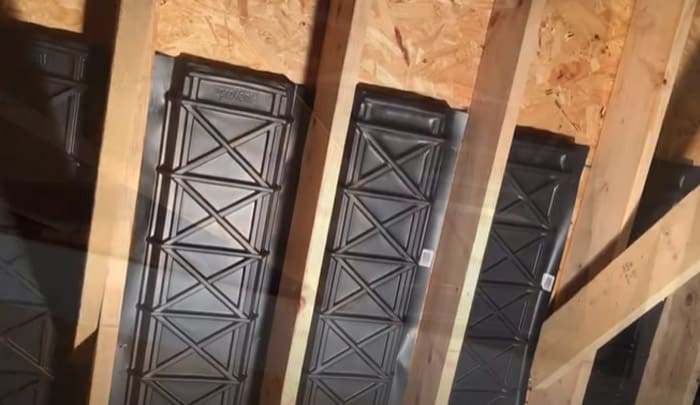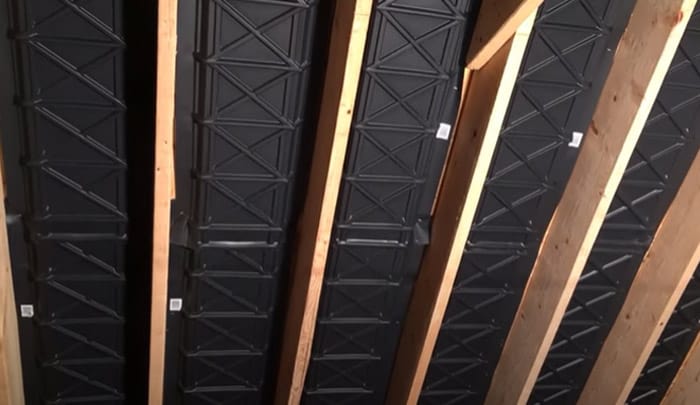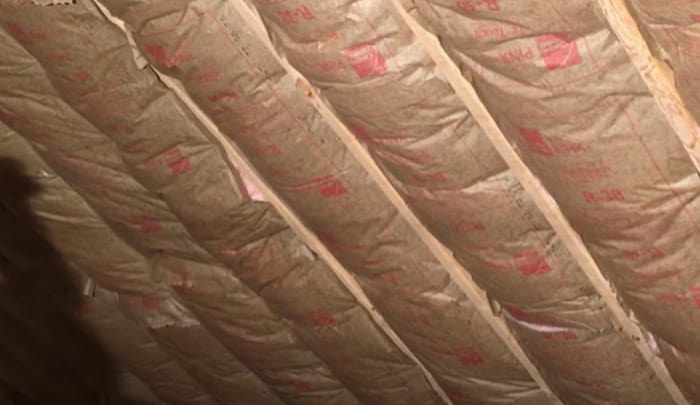You’re here because you’ve noticed that the temperature in your garage is lower than you’d like it to be, and higher than you’d like it to be in the room above it. Don’t worry, insulating the ceiling of your garage is a simple project that can keep that area well-tempered and the rest of your home cozy. We’ll show you how to put your worries about the temperature of your garage to rest and keep the room above it warm. Let’s get started!
Insulation of the garage ceiling will depend on the type of room above it. If it’s an attic, the best option is usually a combination of foam boards and fiberglass batting. If it is a living space, use batt insulation in between the rafters then put drywall underneath to enclose the area.
“Don’t underestimate the influence proper insulation can have on your home’s overall temperature. To effectively insulate your garage ceiling, one should consider the specific type of insulation — blow-in insulation, batts or rigid foam, and also the installation technique. Attention to these details can potentially alleviate nearly 70% of the heat loss that rooms above garages often experience.”
Kelvin Mardale, Building Contractor, Insulation Specialist
Pre-Installation Considerations
Before you begin the installation process for insulating your garage ceiling, there are several factors to consider that can affect the efficacy of insulation in your garage. Key considerations include how large the space is, what climate zone you live in, and whether the room above is heated or not.
If the room above is unheated, you will need to select a higher R-value insulation to ensure adequate heat retention in the garage. Generally speaking, the recommended R-value of insulation, which measures its resistance to heat conducting through a material, increases with colder climates (R-Value Map). If you are uncertain of your climate zone, consult a local HVAC specialist to learn what type of insulation is best suited for your home.
In addition to selecting an appropriate type of insulation, properly measuring and preparing the area for installation must be done correctly. To get started, measure the entire width and length of your ceiling space so you know how much square footage needs to be covered. Once the measurements are taken and recorded, pay attention to any potential wiring or plumbing that may run through the ceiling – you will want them protected from any possible intrusion by the insulation.
Finally, consider if an air/vapor barrier is required in your area to protect against extreme temperatures entering or leaving through your insulated walls. If an air/vapor barrier isn’t already present – consult with a professional building contractor who can advise if this additional layer of protection is needed in your area.
Now that all pre-installation considerations have been made, it’s time to move onto installing insulation the right way.

Installing Insulation the Right Way
Installing insulation the right way is essential for creating a warm space in your garage. It is important to take into account the type of roof and the exterior environment of your garage before installation. Doing so will determine if you need to use water vapor barrier or air barrier when installing insulation.
One side argues that using a vapor barrier is essential for preventing moisture which would otherwise cause problems in either the winter or summer. Installing it between the attic and rear walls of your garage can help improve air quality as well as reduce energy costs by maintaining the warmth inside. Additionally, this added layer of protection can prevent moisture from entering through any gaps within the walls, helping to avoid costly repairs down the road. It’s also important to properly ventilate your garage to further control moisture and temperature.
On the other hand, some argue that because a garage mostly has no occupants, the presence of a vapor barrier isn’t necessary since there is limited exposure to regular moisture. This means that you don’t need to worry about additional air sealing measures to maintain relative humidity levels. As such, many opt for just air barriers as an extra layer of protection against airborne particles and warmer temperatures in winter months, without having to install an additional vapor barrier layer.
At the same time, it is also important to use properly graded insulation material for your particular climate zone and always check local building codes before installation. Ultimately, it depends on the specific needs of your space and how you plan to use it down the road; therefore weighing both sides of this debate is helpful before making any decisions about added moisture protection for your garage ceiling insulation installation.
By following these steps, you will be well on your way towards successfully insulating your garage ceiling to keep it warm all year round. Now we’ll turn our attention to accessing and sealing up the ceiling in order to properly attach insulation material.
- According to the US Department of Energy, attic insulation should be at least R-38, or 11.2 inches thick.
- Inadequate attic insulation can reduce energy efficiency by up to 60%.
- Proper insulation in an attic can save up to 20% on home heating and cooling bills compared to baser thermal conditions.
Accessing and Sealing the Ceiling
Before selecting and installing insulation materials in your garage’s ceiling, you must first access the ceiling to ensure it can be sealed off properly. Depending on the type of material you will use for the job, different ceilings may require different levels of preparation.
If you plan to use a plywood deck with expanded polystyrene (EPS) foam, you’ll need to remove any existing drywall or other materials from the ceiling and install a plywood subfloor as your base layer. This helps provide a better seal and prevents air from leaking between the insulation and the ceiling joists.
Alternatively, if you plan to use rigid foam board insulation, there is no need to remove existing drywall or subflooring. However, making sure that the space above is well-ventilated is essential in order to prevent mold growth due to excessive condensation. You should also take care to plug any cracks or gaps around windows, electrical boxes, pipes and other openings in the garage. Don’t forget about garage door insulation as well—insulating over these without sealing them could still leave warm air exposed to cold temperatures outside.
Once you have accessed the ceiling correctly and sealed all potential air exposure points, you are ready to proceed with choosing and installing insulation materials. The next section will discuss how to do this efficiently and effectively for maximum energy savings.
Choosing and Installing Insulation Materials
When insulating a garage ceiling to keep the room above warm, it is important to choose and install insulation materials correctly. Different types ofGarage Ceiling Insulation exist which can be quite confusing for homeowners. Therefore, it is advisable for homeowners to do their research to determine the best type of insulation for their particular needs.
For example, fiberglass batt insulation is one of the most popular types of insulation. It consists of flexible glass fibers held together by a binder and can be sandwiched between wood or metal studs in walls and ceilings. Its advantages include being cheap, durable, easy to install, and providing good thermal efficiency. However, some people consider fiberglass unsafe due to its tendency to produce dust particles that can irritate skin or lungs.
Alternatively, although spray foam insulation requires a professional installation service and may cost more initially than fiberglass batt insulation, its long-term benefits often make up for the additional expense. Spray foam produces an airtight seal that does not contain gaps or voids and provides superior fire resistance capabilities compared to fiberglass batt insulation. It also adds structural stability which could help protect against seismic activity or changes in temperature due to weather conditions.
Whichever type of Garage Ceiling Insulation homeowners decide on they should look out for certifications such as R-Value (indicating thermal properties). Additionally, they should ensure there are no leaks coming in from outside as this could cause damage to both the garage ceiling and the room above it over time.
Now that you have chosen and successfully installed the right kind of Garage Ceiling Insulation materials, it is essential to keep the temperature consistent in order for your efforts to be effective. In the next section we will discuss how to do just that…

Key Points
Insulating a garage ceiling is an important process that should be done correctly and with the right materials. Fiberglass batt insulation is one of the most popular types, being cheap and durable, though it can produce dust particles. Spray foam insulation requires professional installation, but can provide superior fire-resistance and airtight seal with better thermal efficiency. It is important to look for certifications such as R-Value when choosing materials, and no leaks from outside should be allowed in order to effectively keep the temperature steady.
Keeping Temperature Consistent
There are several ways to ensure you keep the temperature in your garage and the room directly above it consistent, depending on how well insulated your ceiling is and the type of roof you have.
If you have an uninsulated attic over the garage, a great way to keep the temperature consistent is to install an electric fan or blower at the peak of the roof. A fan or blower will create a more consistent climate throughout the attic space regardless of outside temperatures, as it will be able to push hot air down below and expel cold air up through any gable-end walls. Alternatively, if your attic is already insulated, you should focus on sealing off any potential pathways for heat to escape from other areas of your house such as around windows and doors or through poorly fitted weatherstripping. Additionally, consider ways to cool your garage in warmer months to maintain a consistent temperature year-round.
Another option is to use a powered ventilation system with fans in all will serve to capture excess warm air escaping through windows and vents and push it back into the living area. Powered ventilators can also be installed between the two rooms and work by pushing outside air into whichever room needs it most depending on shifts in temperatures. Not only do powered ventilators provide adequate heating, but they also help to prevent mold growth adding another layer of comfort to your home.
For those interested in maximum energy efficiency, one could opt for heat pump systems that can heat and cool both spaces separately from each other ensuring no energy is wasted when moving air between spaces. In addition to improved temperature control during warmer months, this type of insulation can potentially save 10% off yearly utility bills.
Finally, another simple yet effective solution for keeping temperatures steady would be to hang thermal curtains over any garage windows present alongside insulating garage doors where possible. By doing so you prevent any additional drafts from entering your living area which also serves to reduce noise transmission from outside sources.
Now that we’ve discussed several different methods for maintaining consistent temperatures in garages as well as rooms above them, let’s dive into some advantages and disadvantages associated with insulating a garage ceiling in our next section.
Advantages and Disadvantages of Insulating a Garage Ceiling
When considering whether or not to insulate your garage ceiling, it is important to weigh the advantages and disadvantages to determine if this project is right for your home.
Advantages
One of the main benefits of insulating your garage ceiling is increased protection from the elements. An insulated garage can significantly reduce heat loss in winter, resulting in a warmer room above and less need for supplemental heating. In summer, insulation helps keep hot air from outside from entering the room, helping with cooling efficiency. Additionally, an insulated garage can help reduce energy costs and increase energy efficiency over time. Additionally, adding insulation to your garage ceiling can enhance noise control within the space; this can be useful if you happen to have a noisy upstairs neighbor or busy street nearby!
Disadvantages
It is important to recognize that while there are advantages to insulating your garage ceiling, there are some potential disadvantages as well. The primary downside to insulating your garage ceiling tends to be cost; depending on the area you live in and type of insulation you choose, this project can become expensive quickly. Furthermore, certain types of insulation require professional installation and may require additional structural support; this will all add additional labor costs as well. Finally, there are certain types of garages that cannot hold insulation due to lack of ventilation or other issues.
Ultimately, insulating a garage ceiling has both advantages and disadvantages overall. It is important for homeowners to research options carefully before beginning any project as careful consideration must be made before taking on any home improvement initiatives.
After determining if an insulated garage ceiling would work for one’s home, it’s imperative that homeowners understand how to properly maintain their insulation moving forward. The next section will detail necessary after-installation care and detailed maintenance techniques for keeping the room above warm.

After Installation Care and Detail
Once you have installed insulation in the ceiling of your garage, there are some after installation care tips to consider to keep the room above warm and energy efficient. The first step is to check that all insulation has been installed correctly. This way, you can ensure that no cold air will enter through a gap or crack. Additionally, it is important to seal any gaps, cracks, outlets and fixtures which can act as an entry point for outside air.
The next step to ensure continued warmth involves the installation of vapor barriers. Vapor barriers should be used on both sides of your insulation – they protect against the accumulation of moisture and mildew due to its water-resistant material. An extra measure of protection can be achieved with a more robust insulation membrane designed for high-humidity environments like a garage.
It is also recommended that climate controlled air conditioning should not be used in the garage because it typically does not reach temperatures suitable for conditioned indoor spaces. Furthermore, using this device would involve an increase in electricity costs due to the size of the garage space which could potentially negate any energy savings from installing insulation. Instead, use motorized fans to circulate the heated air from the house into the garage and help even out temperature fluctuations.
Finally, the windows should always remain shut when heating or cooling systems are running in order to avoid energy loss due to drafts and normal heat transfer processes. Weather stripping can prevent cold air from entering through seams around doors, windows, and other openings. Once in place, make sure to check regularly for wear and tear during colder months as well as inspect around door frames and corners occasionally for any gaps or openings. These measures will provide assurance that your garage maintains its thermal efficiency so that you are able to enjoy a comfortable temperature all year round in your room above.

Responses to Frequently Asked Questions with Detailed Explanations
Is attic ventilation important when insulating a garage ceiling with a room above?
Yes, attic ventilation is important when insulating a garage ceiling with a room above. Attic ventilation helps to move hot air from the roof to the outside and helps to keep the attic cooler overall which prevents heat from radiating into the room above. Without proper airflow and ventilation, insulation in the garage ceiling could act as a barrier trapping heat within the attic and resulting in uncomfortable temperatures in the room above. Adequate attic ventilation also helps prevent damage to your roof caused by moisture buildup. Additionally, proper insulation and ventilation can help reduce energy costs associated with heating an air-conditioned space.
What types of insulation are suitable for a garage ceiling with a room above?
The best type of insulation for a garage ceiling with a room above is spray foam insulation. Spray foam offers superior coverage compared to other insulation types, allowing it to fully fill in any gaps or voids in your garage structure while providing maximum thermal protection. It is also able to adhere firmly to your ceiling, providing more strength and stability than other forms of insulation and helping to reduce noise transference between the two rooms. Additionally, spray foam provides excellent air sealing capabilities that help keep conditioned air and heated air indoors during extreme temperatures. Finally, this type of insulation is non-toxic, making it safe for use even in enclosed spaces where people may inhabit for extended periods of time.
How can I protect the insulation from moisture or damage in a garage ceiling with a room above?
The best way to protect insulation from moisture or damage in a garage ceiling with a room above is to use insulating foam boards. These foam boards are designed specifically to resist the passage of air, water vapor and airborne particles. They can be installed directly between the joists or rafters of your garage ceiling and will provide a moisture barrier that helps keep the insulation dry and protected from potential damage. In addition, insulating foam boards help maintain heat in the room above by reflecting heat back into the space, providing an extra layer of protection for both your insulation and your upper rooms.
References
https://www.thespruce.com/types-of-garage-installation-1398128
https://www.thisoldhouse.com/heating-cooling/21015334/how-to-reduce-home-heating-costs





With my experience, I can affirmatively say that the right kind of insulation can make a significant difference in the overall temperature regulation, contributing to energy efficiency.
In my day-to-day teaching experience, I have honestly found insulation to be a crucial aspect of making any space energy efficient, like Runnells mentioned. Interestingly, when I decided to insulate my garage ceiling a few summers ago, I immediately noticed a stark reduction in my home’s overall HVAC use, greatly improving my energy efficiency.
When I insulated my garage, I noticed a significant difference in the comfort of not just the room above, but the entire house. The heating bills also took a pleasant dive which was an added bonus. It’s a project that takes time and effort, but the benefits are worth it in my experience.
The day I decided to insulate my basement, it turned into a weekend-long project, but it was undeniably worth it. Not only did the rooms above become more comfortable, but our energy bills also decreased, making it a beneficial long-term investment.
I resonate with Seraphina’s sentiments about the benefits of insulation. As a long-time carpenter, I can swear by the considerably decreased energy bills and improved comfort levels post-insulation. Insulating your garage ceiling might seem complicated, but it’s actually straightforward if you understand the basics. Besides ensuring a snug space above your garage during cold months, it also plays a fundamental role in reducing any noise pollution from other machinery or equipment stored there.
Quinton, you couldn’t be more correct about the reduction in noise pollution, an added perk I didn’t consider initially but was pleasantly surprised by post-insulation.
Jarvis, you’re spot on about the unexpected reduction in noise pollution; it also worked wonders for my cozy home office located just above the garage!
As a retired engineer who has insulated his own garage ceiling, I can attest to the drastic difference it makes, especially if you live in an area with harsh winters. It’s amazing how much heat can be lost via the garage without proper insulation. Plus, insulation is not just about warmth, but also about reducing energy costs.
You nailed it, Zion! I’m also speaking from personal experience when saying that proper insulation significantly diminished my energy bills during the winter months. It not only creates a comfortable environment for the room above but indeed contributes to house-wide energy efficiency.